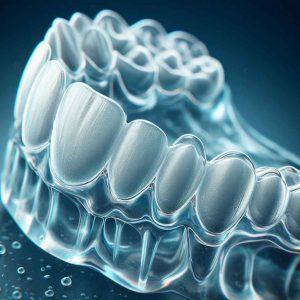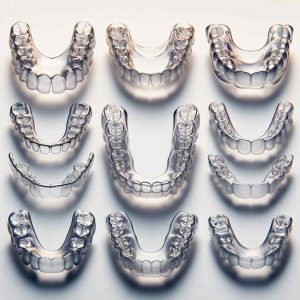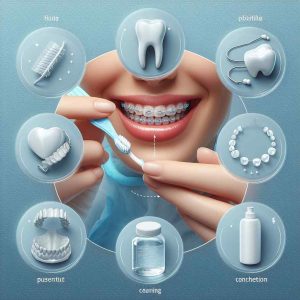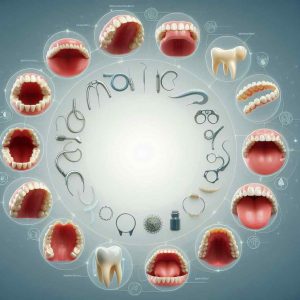Table of Contents
ToggleThe Importance of Clear Retainers Post-Aligner Treatment
Achieving a perfect smile is a milestone worth celebrating. It’s a testament to your commitment and the journey you’ve embarked on with aligner treatment.
This journey, often filled with anticipation and excitement, leads to a moment of joy when you first see the transformation in your smile.
But the journey doesn’t end there.
The key to maintaining this perfect smile lies in a small, often overlooked device known as the clear retainer.
Considered the ‘perfect end’ to aligner treatment, clear retainers play a crucial role in preserving the beauty of your new smile.
This guide aims to shed light on the importance of clear retainers and why they are an integral part of your orthodontic journey.
So, let’s dive in and explore how you can keep that perfect smile for years to come.
Why Clear Retainers?
Clear retainers are almost invisible, making them an excellent choice for those who want to maintain their new smile without drawing attention to their dental care routine.
For the best results, wear your clear retainers as directed by your orthodontist.
This usually means wearing them full-time for a few months after completing your aligner treatment, then gradually shifting to wearing them only at night.
Proper care extends the life of your clear retainers. Clean them regularly with a soft brush and lukewarm water, and store them safely when not in use.
Your journey to a perfect smile doesn’t end with aligner treatment. By using clear retainers, you’re committing to maintaining that smile for years to come.
Why are Retainers Necessary After Aligner Treatment?

The Memory of Teeth
Teeth, much like the rest of our body, have a certain “memory” of their original position.
After undergoing aligner treatment, there’s a natural tendency for teeth to shift back to their initial positions.
This is due to the elastic nature of the periodontal ligament, the tissue that holds the teeth in place in the jawbone.
When teeth are moved to a new position, this ligament is stretched and it naturally wants to return to its original shape, pulling the teeth back with it.
The Role of Retainers
This is where retainers come into play.
Retainers are custom-made devices, usually made of wires or clear plastic, that hold teeth in position after surgery or any method of realigning teeth.
They are crucial in stabilizing the new position of your teeth and preventing a relapse, i.e., the teeth moving back to their original position.
How Clear Retainers Work
Clear retainers are a popular choice due to their near-invisibility when worn.
They are custom-made to fit your teeth and are worn at night to keep your teeth in place. The retainers work by holding the teeth in their new position long enough for the periodontal ligament to adjust to its new shape.
This is crucial in maintaining the perfect smile achieved through aligner treatment.
Retainers and Bone Adaptation
Retainers also play a significant role in allowing the surrounding bone and tissues to adapt to the new tooth positions.
When teeth are moved, the bone around the teeth remodels to support the teeth in their new position.
Retainers give the bone and tissues the necessary time to adapt, ensuring the long-term stability of the new tooth alignment.
While achieving a perfect smile with aligner treatment is a big accomplishment, maintaining that smile with clear retainers is equally important. It’s not just about getting the perfect smile, but keeping it too!
Types of Clear Retainers

After aligner treatment, it’s crucial to maintain the new position of your teeth to ensure the longevity of your perfect smile. This is where clear retainers come into play.
There are two main types of clear retainers: Essix retainers and fixed retainers.
| Types Of Retainers | Description |
| Essix Retainers | Essix retainers are thin, clear, plastic retainers that are custom-made to fit your teeth. They are designed to be virtually invisible when worn, allowing you to maintain your new smile without anyone noticing you’re wearing a retainer. Essix retainers are removable, which means you can take them out when eating or brushing your teeth. This makes them a convenient and hygienic option for many people. |
| Fixed Retainers | Fixed retainers, on the other hand, consist of thin wires that are bonded to the back of your teeth. They are a more permanent solution as they are not removed during eating or brushing. While they offer excellent stability, they require careful cleaning and regular dental check-ups to ensure optimal oral health. |
Essix retainers are often the more common type used after aligner treatment. Their comfort, removability, and aesthetics make them a popular choice for many individuals.
Remember, the goal is not just to achieve a perfect smile, but to maintain it. And with the right type of retainer, you can ensure your smile stays perfect for years to come.
Wearing Schedule and Care for Clear Retainers

Recommended Wearing Schedule for Clear Retainers
After your aligner treatment, it’s crucial to follow the recommended wearing schedule for your clear retainers.
Initially, you should wear your retainers full-time for the first few months.
This means wearing them day and night, removing them only for eating, drinking anything other than water, and brushing your teeth.
As your teeth stabilize in their new positions, you can gradually reduce the wearing time. Eventually, you’ll only need to wear your retainers at night.
However, remember that every person’s teeth are different, and your orthodontist will provide a wearing schedule tailored to your specific needs.
Importance of Cleaning and Storing Retainers
Proper care for your retainers is just as important as wearing them. Retainers should be cleaned regularly to prevent damage and bacteria growth.
Here’s a simple routine for cleaning your clear retainers:
| Steps for Aligner Cleaning | Description |
| Rinse | Always rinse your retainers when you remove them from your outh. |
| Clean | Use a soft toothbrush and non-abrasive toothpaste to gently clean your retainers. Alternatively, you can use a retainer cleaner as recommended by your orthodontist. |
| Soak | Soak your retainers in a denture cleaning solution or retainer cleaning solution once a week to disinfect them. |
| Rinse Again | Rinse your retainers thoroughly under running water before putting them back in your mouth. |
Common Mistakes to Avoid
While clear retainers are easy to use, there are some common mistakes that you should avoid:
| Mistakes to Avoid | Description |
| Forgetting to Wear Your Retainers | Consistency is key when it comes to retainers. Make sure to wear them as per your orthodontist’s instructions. |
| Losing Your Retainers | Always store your retainers in their case when not in use to avoid misplacing them. |
| Not Cleaning Your Retainers | Regular cleaning is crucial to maintain the hygiene of your retainers and prevent bacteria growth. |
With clear retainers, a proper wearing schedule, and good care habits, you can maintain your perfect smile for years to come!
Potential Concerns and Addressing Them

While clear retainers are an essential part of maintaining your perfect smile, it’s natural to have some concerns about wearing them.
Here, we’ll address some of the most common concerns and offer solutions to make your retainer-wearing experience as comfortable as possible.
| How to Address the Concerns | Description |
| Discomfort | One of the most common concerns about wearing clear retainers is discomfort. It’s normal to feel a little discomfort when you first start wearing your retainers. This is because your mouth is adjusting to the new device. To alleviate this, you can start by wearing the retainers for shorter periods initially, gradually increasing the duration as your comfort level improves. |
| Speech Impediment | Another concern is the potential for a temporary speech impediment when you first start wearing your retainers. This is because your tongue needs to adjust to the presence of the retainers. A good way to overcome this is by practicing speaking with the retainers in. Reading aloud or carrying out a conversation can help you get used to them faster. |
| Difficulty Cleaning | Your retainers clean can seem like a daunting task, but it doesn’t have to be. Regular cleaning, as discussed in the previous section, can prevent bacteria growth and keep your retainers in good shape. Remember to rinse your retainers every time you remove them and clean them with a soft toothbrush and non-abrasive toothpaste. |
However, if you have any questions or concerns, it’s important to speak with your dentist or orthodontist. They can provide you with personalized advice and solutions to ensure that your retainer-wearing experience is as comfortable as possible.
After all, these clear retainers are the key to maintaining that perfect smile you’ve worked so hard to achieve.
Frequently Asked Questions (FAQs)
Q. Do Clear Retainers Hurt?
Ans. Clear retainers may cause slight discomfort initially as your mouth adjusts to them, but this discomfort should subside after a few days. If the discomfort persists, consult your orthodontist.
Q. Are Clear Retainers Better Than Metal?
Ans. Clear retainers are more aesthetically pleasing than metal ones as they are virtually invisible. However, the choice between clear and metal retainers depends on individual needs and preferences.
Q. How to Take Clear Retainers Out?
Ans. Clear retainers can be easily removed by gently pulling on them. Always remove them from both sides simultaneously to prevent any damage.
Q. How Much Do Clear Retainers Cost in Pakistan?
Ans. The cost of clear retainers in Pakistan can vary depending on various factors. It’s best to consult with a local orthodontist for the most accurate pricing.
Q. What’s the Best Way to Clean Your Clear Retainers at Home?
Ans. Clear retainers should be cleaned daily with a soft toothbrush and non-abrasive toothpaste. They can also be soaked in a denture cleaning solution once a week for a deeper clean.
Q. Can You Drink Coffee With Clear Retainers?
Ans. It’s not recommended to drink coffee or any other colored beverages with clear retainers in, as they can stain the retainers.
Q. How Long Do Clear Retainers Last?
Ans. With proper care, clear retainers can last for several years. However, they may need to be replaced if they become cracked or warped.
Q. How Do Clear Retainers Move Teeth Back?
Ans. Clear retainers help to hold the teeth in their new position after orthodontic treatment, preventing them from moving back to their original position.
Q. How Long Do You Have to Wear Clear Retainers?
Ans. Initially, clear retainers should be worn full-time. Over time, you can reduce the wearing time to only at night. Your orthodontist will provide a specific wearing schedule based on your individual needs.
Q. Can You Drink Water With Clear Retainers?
Ans. Yes, you can drink water with clear retainers in. However, they should be removed when consuming any other beverages or food.
Q. Can You Eat With Clear Retainers?
Ans. No, clear retainers should be removed when eating to prevent damage and to maintain proper oral hygiene.
Q. Should You Clean Clear Retainers With Vinegar and Baking Soda?
Ans. While some people use a solution of vinegar and baking soda to clean their retainers, it’s best to follow the cleaning instructions provided by your orthodontist to avoid damaging your retainers.
What We’ve Learnt
The journey to a perfect smile doesn’t end with aligner treatment.
Clear retainers play a crucial role in maintaining the beautiful smile you’ve worked so hard to achieve. They ensure that your teeth stay in their new, perfect positions, preserving the results of your treatment.
Regular checkups with your dentist are essential to monitor your teeth and retainers. These visits allow your dentist to ensure that your retainers are doing their job and that your teeth remain in their desired positions.
Having a healthy, maintained smile brings a sense of confidence and freedom. It allows you to express yourself freely, knowing that your smile is at its best.
Ready to Take the Next Step?
If you’re considering invisible braces to beautify your smile, we’re here to help. We provide FDA-certified invisible braces in Pakistan and abroad.
Our customer service team is ready to assist you with the next steps while ensuring your privacy.
Please fill out our contact form, and we’ll get back to you as soon as possible.
Remember, a beautiful smile is an investment in your self-confidence and oral health. Let us help you achieve the smile you’ve always wanted.











